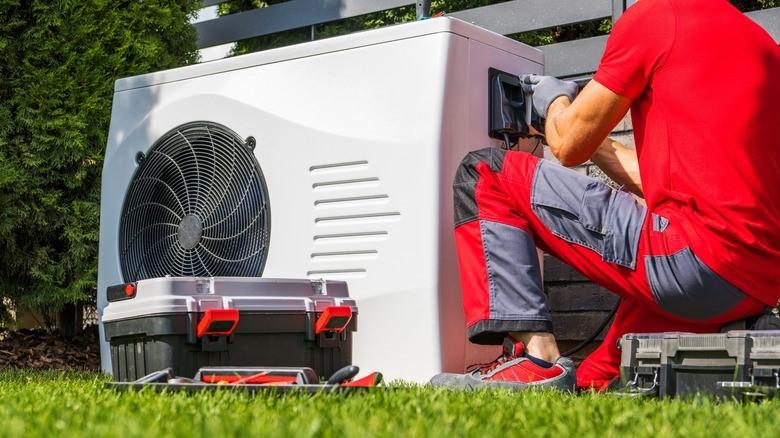As the vibrant colors of fall fade, and the temperature drops, it’s a clear sign that winter is just around the corner. For pool owners, this means it’s time to start thinking about winterizing their beloved backyard oasis. Among the essential components to prepare for the cold season, the pool heater deserves special attention. Winterizing your pool heater is a critical step to ensure its longevity and proper functioning when the swimming season returns. In this comprehensive guide, we will walk you through the necessary steps to winterize your pool heater effectively, safeguarding it from the harsh winter weather.

Why Winterize Your Pool Heater?
Your pool heater is a valuable investment that requires proper care to maintain peak performance. Winterizing the heater serves several important purposes:
· Prevents Freeze Damage
Freezing temperatures can cause severe damage to pool heaters. Water left inside the unit can freeze, expand, and lead to cracks, leaks, or even total destruction of the system.
· Extends the Lifespan
By taking the time to winterize your pool heater, you are protecting its components from wear and tear caused by exposure to cold and moisture, which can extend its lifespan significantly.
· Saves on Repair Costs
A well-maintained and properly winterized pool heater is less likely to suffer from damage, reducing the risk of expensive repairs in the future.
Now, let’s delve into the step-by-step process of winterizing your pool heater.
1. Clean and Inspect
The first step is to thoroughly clean your pool heater. Remove any debris, leaves, and dirt that may have accumulated during the swimming season. This will prevent clogs and blockages in the system during winter. As you clean, take the opportunity to inspect the heater for any signs of wear, rust, or corrosion. Addressing these issues before winter sets in can help prevent further damage.
2. Turn Off and Disconnect
Before proceeding with winterizing your pool heater, switch off the power supply to the unit. This precautionary measure ensures safety during the winterization process and prevents any electrical mishaps. Next, disconnect the pool heater from the pool’s circulation system. This step ensures that no water will flow into the heater during winter, reducing the risk of freeze damage.
3. Drain the Water
Draining the water from your pool heater is one of the most critical steps in the winterization process. Be sure to follow the manufacturer’s instructions on how to drain your specific type of pool heater. Different heaters may have different draining methods. Some pool heaters have a built-in drainage plug, while others may require you to disconnect hoses or use a pump to remove the water. Proper drainage is essential because even a small amount of residual water left inside the heater can lead to extensive damage when frozen.
4. Remove and Store Detachable Parts
Many pool heaters have detachable components, such as temperature sensors, pressure switches, or flow switches. Carefully remove these parts and store them in a dry and safe place for the winter. This precaution prevents these components from being damaged by the cold temperatures or exposure to moisture.
5. Insulate Exposed Components
For pool heaters that are not entirely enclosed, such as gas heaters, it’s essential to provide additional protection against freezing temperatures. Use insulation materials, such as pipe insulation or foam, to cover exposed pipes, fittings, and any other vulnerable components. Insulating these parts will help safeguard them from winter weather conditions.
6. Cover the Heater
Once you have adequately prepared your pool heater, cover it with a waterproof and weather-resistant pool heater cover. This cover acts as an extra layer of protection against snow, ice, and moisture. It will help keep your heater dry and shielded from the elements during the winter months.
7. Regular Maintenance Checks
Throughout the winter, it’s essential to periodically inspect your pool heater. Remove any snow or ice buildup from the cover to ensure it remains in good condition. Check for any signs of damage or leaks. If you notice any issues, consult a professional pool technician for appropriate repairs.
8. Spring Start-Up
When winter comes to an end, and you’re ready to open your pool for the new season, it’s time to reverse the winterization process. Reconnect the pool heater to the circulation system, fill it with water, and turn on the power supply. Before resuming normal operation, thoroughly inspect the heater and its components for any damages that may have occurred during the winter.
Winterizing your pool heater is a crucial step in protecting this valuable investment from potential damage caused by freezing temperatures. By following these steps and taking the necessary precautions, you can ensure your pool heater remains in excellent condition and ready to provide warm and comfortable pool water when the swimming season returns. Proper winterization not only protects your pool heater but also extends its lifespan, reduces the risk of expensive repairs, and allows you to enjoy your pool for many years to come.





